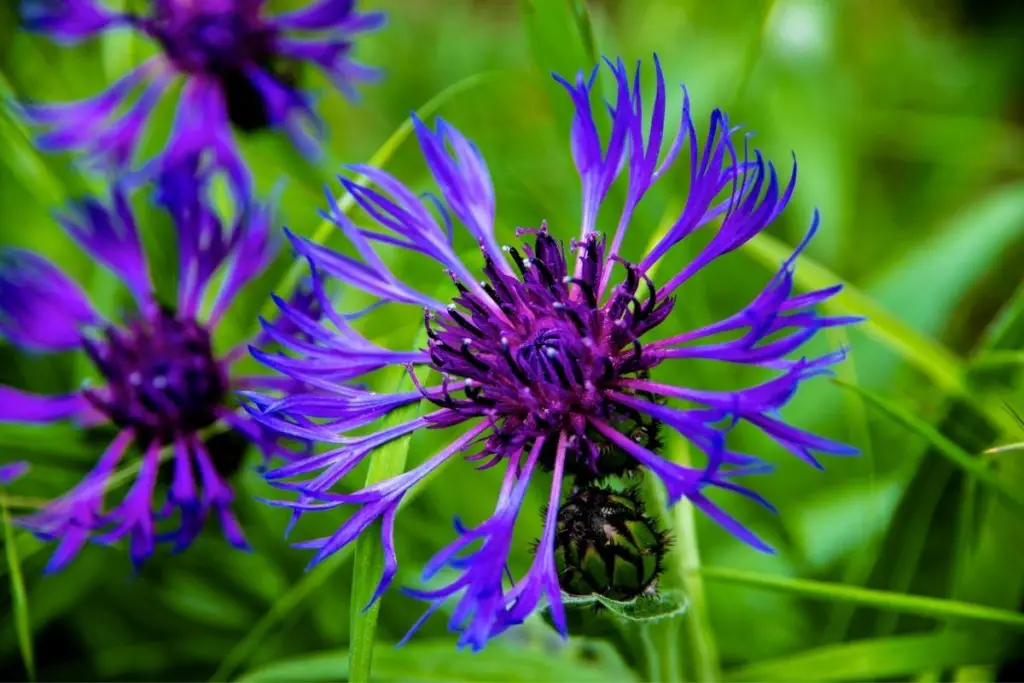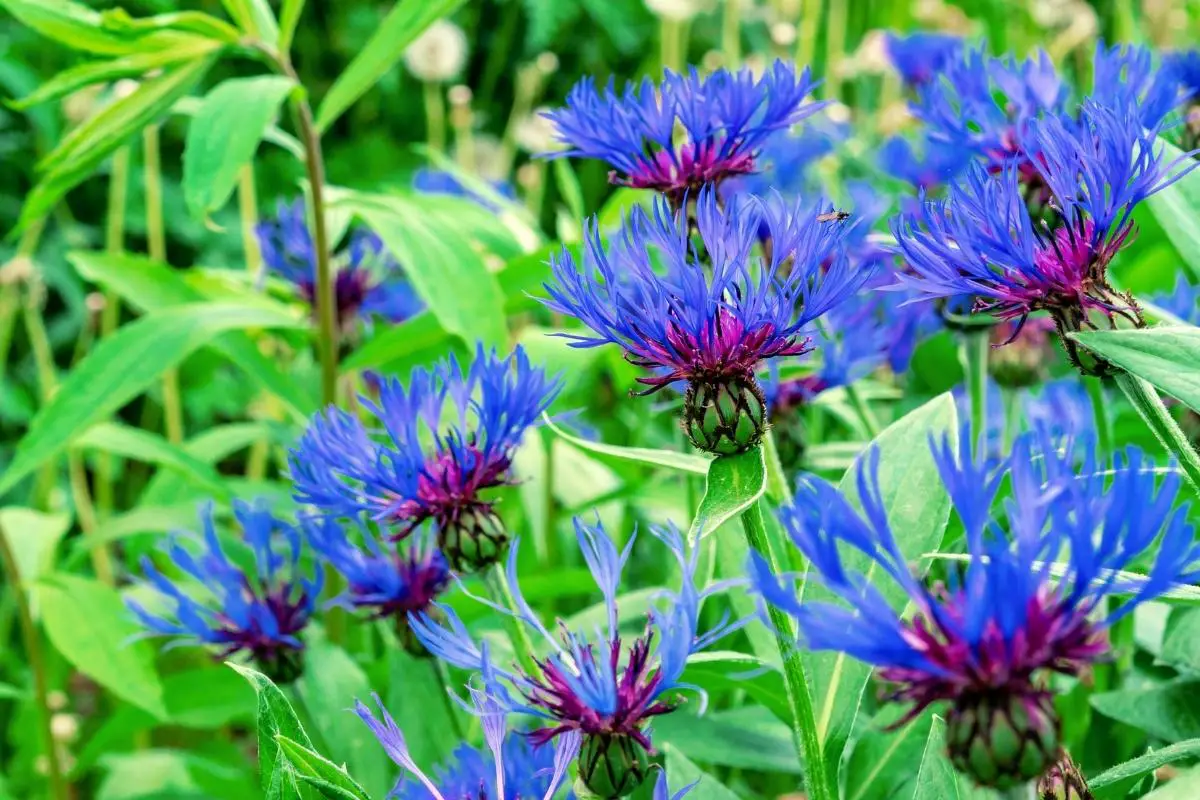The Centaurea montana may be one of the most interesting visual perennial flowers from the daisy family that has been dubbed ‘Asteraceae’. It’s more commonly known as the ‘Mountain Bluet’ perennial flower and catches people’s attention with its sharp and dark blue color patterns.
The Mountain Bluet is native to the European continent. It is considered to be a common ‘cornflower’ that ultimately grows to be up to three feet in total height. They have a sweet and intoxicating aroma. Due to its incredible spreading potential, it’s not uncommon for Centaurea montana to be considered an extremely invasive flower.
An even more impressive aspect of this perennial cornflower is that it is capable of surviving moderate droughts and can handle soils with less than ideal quality. The leaves of the Mountain Bluet can be green, gray, and even silver. Source.
Just like its name suggests, the Mountain Bluet can be found in the mountain ranges across the southern portions of Europe. If you are struggling to identify this unique and vibrant cornflower, you will want to understand its visual characteristics.
These characteristics include dark blue circular flowerheads with a dark red or purple interior. They are commonly found to be between one and three feet in total height. This unique perennial flower grows best in full sun conditions, but can also tolerate some shade.
Table of Contents
Where Does Mountain Bluet Grow the Best?
The mountainous regions across Europe aren’t the only places where Mountain Bluets can grow and thrive. Just about any environment that shares similar weather and climate characteristics could be a great place for these perennial flowers to grow.
Mountain Bluets indeed prefer slightly cooler temperatures. They can grow optimally at around 60 degrees Fahrenheit, although they are tolerant of just about any reasonable temperature. It has been well documented that Mountain Bluets prefer a lot of sunlight, so full sun conditions are a desirable characteristic of the local environment.
The soil quality has a major impact on the growth potential for the Mountain Bluet. Moist soil is ideal for the best growing conditions, but it’s still possible for exceptional growth even in poorer soil quality. It’s important to remember that while these types of perennial flowers can sometimes survive without a whole lot of water, they can thrive ideally with approximately an inch of water every seven days.
While not the native lands of this perennial cornflower, the Mountain Bluet is currently known for thriving across various parts of North America and Scandinavia. It has ideal perennial characteristics that allow it to spread quickly and resiliently.
Can the Mountain Bluet Be Poisonous to Humans?
There is no evidence that the ‘Mountain Bluet’ is harmful to humans in any way. No side effects from direct contact have ever been documented. There are no harmful toxins known that could potentially be hazardous to human beings in any way.
The same thing can be said about the ‘Centaurea montana’ when it comes to exposure towards animals. There are no documented toxins that could poison an animal. It is however important to remember that the ‘Mountain Bluet’ is not really considered to be edible by humans.
What is the Average Size of the Mountain Bluet?
The Mountain Bluet is capable of growing up to three feet in height. Reaching a full three feet is actually pretty rare though. It is much more common for it to reach around two feet on average. The flowers are around 2 inches in diameter. They make long “ray petal flowers.” Source.
In terms of spread and width, Centaurea montana can spread to be from anywhere between a foot and two feet. In some regions, this flower has been designated as an invasive plant because it is capable of rapidly spreading due to its massive growing potential. It can generally spread very quickly due to its self-seeding capabilities.
Which Months Does the Mountain Bluet Bloom?
You might not be surprised to hear that the ‘Mountain Bluet’ commonly blooms between the early months of Spring and the later months of Summer. So, you will most commonly find the ‘Mountain Bluet’ thriving into a prosperous bloom between March and August.
Seasonal maintenance is required for optimal growing conditions for this perennial flower. When properly maintained, you’ll find that these vibrant flowers can burst into a masterpiece of dark blue flower tips with a solid dark purple center that also shares tints of the color red.
A lot of sunlight is required every single day for the ‘Mountain Bluet’ to thrive to its maximum potential. If you are planting this flower around the spring, make sure to water it appropriately so that it can ultimately grow and bloom.

What Are Common Colors for the Mountain Bluet?
You might be wondering if the ‘Mountain Bluet’ perennial flower comes in any additional colors beyond the dark blue and purple-tinted flower tips that we have already described.
The dark blue and purple cornflowers are extremely common. It is rare for them to be any other color when blooming. The centers of these flowers can shift between dark red and dark purple.
For more Types of Blue Flowers – Click here.
Related Questions
Which types of gardens are best for the ‘Mountain Bluet’?
Alpine gardens could be an ideal choice if you are looking for a way to successfully grow ‘Centaurea montana’. Other types of rock gardens may also be ideal selections when trying to help this perennial flower grow. Any location with cooler temperatures and a lot of full sunlight should be ideal though.
What is the symbolism of the ‘Mountain Bluet’?
There are mixed perspectives on the general symbolism towards ‘Centaurea montana’. Many people believe that this flower serves as a symbol of hope, wealth, and prosperity. Others would rather connect this flower’s name with its internal medicine-based properties.

